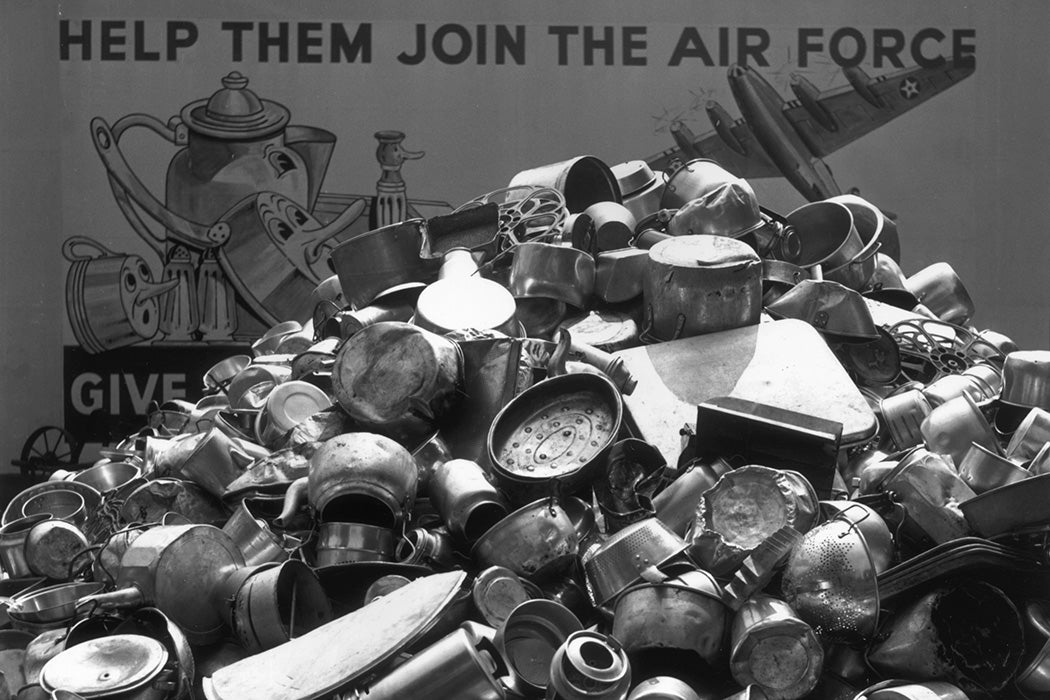The environmental history of warfare is grim. The deforested moonscapes of World War I’s trenches; the atomic bombings of Japan; Agent Orange; depleted uranium rounds—war is hell on our planet.
But the effects aren’t just on the battlefield. War production has often meant environmental catastrophe along the commodity chain. Geographer Matthew Evenden, defining a commodity chain as “linked labor and production processes involved in the making of a commodity from production to finished good,” explores the global aluminum industry during World War II.
Lightweight and strong, aluminum’s importance for aircraft production was recognized in World War I. Production burst all records by 1940, and only a few years after World War II, both consumer culture and ever-growing military spending brought demand right back up to the war’s peak levels.
While aluminum is one of the world’s most common elements, you can’t find it in industrial strength just anywhere. You need bauxite, an aluminum ore. One of the most important sources of bauxite for the Allied war effort was British Guiana (called Guyana since 1966). There, forests were stripped and soils destroyed as a racially segregated workforce—well-paid white British, Canadian, and American administrators and low-wage Afro-Guyanese laborers—played out a colonial power dynamic. The ore was gathered in Trinidad before being shipped north to a smelting plant on Quebec’s Saguenay Peninsula.
Aluminum production requires massive amounts of electrical power—in the industry, aluminum was known as “baked electricity.” A massive regional power grid, uniting dams built especially to fuel the aluminum processing, stretched across Quebec and reached into neighboring Ontario.
Another component of the process was the mineral cryolite, commercially obtainable only from a mine in Greenland. Cryolite, which has the distinction of being the only mineral on the planet to ever be commercially mined-out, made the smelting and refining process more cost-effective.
The smelting plant—named Arvida, after aluminum king Arthur Vining Davis—was enormous: a mile and half long by three-quarters of a mile wide. The ingots of aluminum it produced were shipped to rolling mills and fabricating plants in Canada, the U.S., Britain, and even Australia. Although mined and processed by corporations, production was heavily militarized during the war. The Canadian military protected the Arvida facilities; Americans guarded the Trinidad transshipping center.
Weekly Newsletter
The environmental costs of all this were massive: “The legacy landscapes of bauxite mining are best described as lunar: pocked, mineralized surfaces, devoid of topsoil, flora, or fauna,” writes Evenden. In northern Canada, dam construction and electrical grid expansion radically transformed rivers and landscapes, affecting both indigenous peoples and animal populations, especially fish. The smelting process released polynuclear aromatic hydrocarbons (PAHs), known carcinogens, into the air and water, and ultimately into mammal bodies, from humans to whales.
As Evenden explains, this production cycle—including vast fields of junked aircraft at war’s end—can be seen as a preview of the interconnected, environmentally devastating commodity chains of our world today. Much of what we buy gets to us after long and involved, but virtually invisible, travels that seem to be designed to erase their true social, political, and environmental costs. Even at peace, Evenden writes, we “gather and scatter materials with untold human and environmental consequences.”







